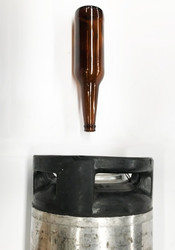Keg vs Bottle
By Greig McGill
If there’s one part of brewing that most home brewers seem to dislike, it’s bottling. All those individual bottles to clean and sanitise. Fretting over whether to bulk prime, or prime bottles individually. Labelling and removing old labels. Dealing with the occasional leaky crown seal. Storing the bottles at just the right temperature to ensure good conditioning. Yep, bottling is a bit of a pain! No wonder a lot of people pack it all in and move to kegging.
Is there a qualitative difference between bottle conditioning your beer and force carbonating beer in a keg? Perhaps, but first let’s talk about some definite differences between the two methods.
One immediate advantage that bottle conditioning has over forced carbonation is the oxygen scavenging nature of the yeast when given some priming sugar. While there will still be yeast in your kegged beer (unless you sterile filter), it will be mostly dormant without a source of new fermentable material, and thus won’t shift into oxygen scavenging/growth phase. In the bottle, with a bit of priming sugar, the yeast will absorb a lot of the available oxygen in order to multiply before consuming the sugar. This will ensure your beer has a longer shelf life before developing oxidised qualities. On the other hand, crown seals are not completely airtight, and some oxygen ingress does occur over time – typically at a rate of seven parts-per-billion per day, depending on the type of bottle and crown seal. Contrast with a keg, which is airtight, and thus will not admit any more oxygen.
Force carbonation in kegs brings with it a level of consistency that can be difficult to achieve with bottle conditioning. After all, there are really only three variables to play with – temperature, pressure, and time. Yes, you’ll need to calibrate pressure for height above sea level where you are, but it’s a minor change in most parts of New Zealand, and isn’t really going to have much of an impact on the final result. It’s also a constant (unless you move) so the same value will give the same result every time. Bottle conditioning to perfection, by contrast, relies on knowing your yeast cell density, viability, exact amount of sugar added, abv and pH of the beer, and a bunch of other minor variables if you want to be completely consistent. Of course, most brewers don’t bother with this, but then they also have pretty wildly varying carbonation levels in their beer. This is especially evident when judging at homebrew competitions!
Another practical advantage to force carbonation is clarity and minimisation of waste. As there’s no sediment left over, the beer is bright and clear, devoid of flavour-harming yeast haze, and you’re not wasting a portion of beer each time you pour one for fear of disturbing the sediment in the bottle.
Now we get to the qualitative part! Is there a difference in carbonation produced by bottle conditioning versus force carbonation? The short and simple answer is no. CO2 is CO2, and the process of it dissolving in beer is identical, no matter how it gets there. With that said, often a bottle-conditioned beer can be perceived to have a finer bead, or produce a more mousse-like head. This is most likely caused by more yeast remaining in suspension, causing nucleation sites for CO2 to come out of solution in a more dispersed manner. The mouthfeel aspect could even be the yeast itself creating a fuller mouthfeel, and contributing to the sense of finer carbonation.
Are there horses for courses when it comes to which method you should use for your beer? I’d say so. If you want your beer to age in the most natural way possible, slowly reacting to oxygen ingress, and changing character subtly over time, I’d recommend bottle conditioning as the way to go. If you want to drink your beer as fresh as possible, as well as achieving the most consistent level of carbonation, I’d go with force-carbonating in keg every time. If you’re entering beer for competition, let the style dictate which you use. For that Old Ale, which should show hints of oxidative aging, some bottles carefully maintained might help get the gold medal over a keg version of the same beer. For an IPA? I’d suggest bottling from the keg as close to competition date as possible, capping on foam, and keeping that bad boy icy cold.
